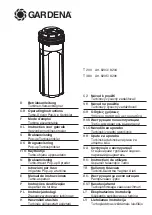
•
A warranty card. Please fill out and return to activate your warranty.
•
Instruction manual.
What accessories are recommended?
•
Eyepieces. Simple eyepieces with narrow field of view are recommended. (25mm thru 8mm)
•
An adapter plate to securely mount the LS60FHa to your scope.
•
Sol Searcher. This attaches to the clamshell assembly and makes finding the Sun allot easier.
•
Dovetail.
•
Sun block, a Lunt Solar hat, and a nice comfortable light colored chair.
Safety First!
•
Always check any telescope or filter before use. Do not use any telescope or filter that appears to be
damaged. Verify that all glass and filters are in place. Contact Lunt Solar with any questions before use!
•
The Blocking Filter diagonal must ALWAYS be used with the Lunt Telescope or Filter. Lunt Filters and
Blocking Filters are NOT interchangeable with products from other vendors.
Okay let's get started...
So you have your LS60FHa filter set and your telescope.
•
Do not point your telescope at the sun until your filter set is fully mounted and secure on the telescope. If you have
any questions about mounting or your filter set please contact our customer service.
•
Thread or slip on your Lunt Solar Systems adapter plate to the front of your telescope. If the adapter plate is a slip
on make sure thumb screws have been tightened and are secure. Lunt Solar Systems only guarantees the
performance and safety of our filters when used the Lunt Solar adapter plate. Please ask about specific models for
your telescopes.
•
Thread the Lunt Solar Systems front etalon into the adapter plate.
•
Slide the drawtube of the Lunt Solar Systems blocking filter into your focuser and tighten the retention system of
your telescope.
•
Place a 25mm eyepiece in the end so you have the largest field of view to look at.
•
Pull the diagonal slide tube out about 25mm.
•
Put the focus at about 50% of travel.
•
Align the Sol Searcher.
•
If you do not have a Sol Searcher you can use the shadow cast by the Sun on the front filter cell against the
clamshell or mounting rings. Center one on the other and you should be close.
•
Look thru the eyepiece. Do you see a fuzzy red ball? If not, make sure you have removed the dust cap from the
front. Try to re-align the Sol Searcher and look again. After some trial and error the Sun should appear in the
eyepiece. Once the Sun is centered adjust the Sol Searcher.
•
Focus: I am amazed how many people walk up to a solar telescope and take a quick look thru without ever
focusing. Course focus is achieved by moving the diagonal drawtube in and out. Medium focus is achieved thru
your focuser as usual. Focus so that the edge of the Sun is as sharp as possible.
•
Tuning: Here is where the magic begins. On the filter is a small brass wheel recessed into the filter housing. Move
the knob all the way to the right when standing at the eyepiece end. Do NOT force the wheel. While looking thru
the instrument slowly move the wheel to the left. After about 4-5 turns you should have seen the edge detail of the
Sun come into view and then fade away again. Move the wheel back in the other direction until the prominences
are most vivid. Moving the wheel from here in either direction should have little visual effect on the image but more
or less surface detail may become apparent. Personal preference will specify where the tuning point is dependant
upon what you like to observe. Once tuned, there should be no reason to re-tune during an observing session.
•
Re-Focus. When you feel you have tuned effectively, re-focus the telescope. The finer details should come into
view. Try to relax the eye while observing and let the details come to you.
•
Change the eyepiece. When you have a good feel for observing at lower magnifications try to increase the
magnifications in small steps. Place an interesting artifact in the center of the field. Replace the 25mm with a
12mm eyepiece. Look thru the eyepiece and re-focus carefully. The image has dimmed slightly due to higher
magnification but the details should be easier to see. You can push the magnification as seeing conditions allow.
At any point you can return to the 25mm, re-align the system and try again.
for tips and insight on how you can get more out of your Solar Filter. Topics
that will soon be covered include:
•
Imaging: Just how does one go about taking a picture?
•
Double-stacking: You'll hear a lot about the advantages of double-stacking your system.
!
3
Lunt Solar Systems * 2520 N. Coyote Dr. #111 Tucson, AZ 85745 * (520) 344-7348
www.luntsolarsystems.com






















